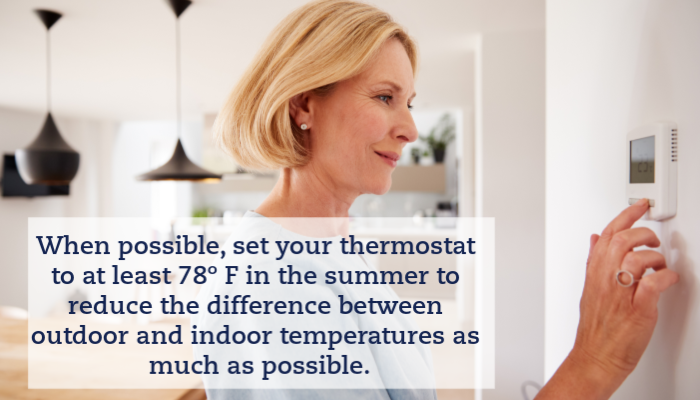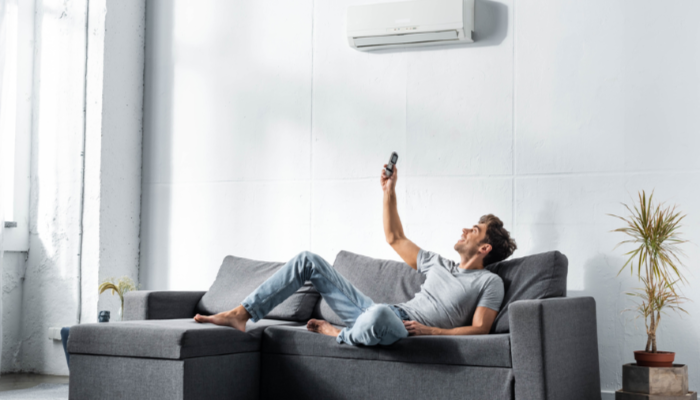Across the country, people are bracing for higher summer electric bills than usual as a result of COVID-19.
During a normal summer, professionals are able to offset some of their electricity usage by commuting to work, where they can enjoy the cool blast of the office air conditioning (AC) without paying a dime. But this summer will be far from normal. With shelter-in-place orders set to continue into the summer, the majority of us will be home—and running our ACs—more than ever before. That can add up to an astronomical electric bill.
And when it comes to air conditioning costs, where you live makes a difference. Consider that an average electricity bill in a state like Texas is about 30 percent higher than it is to the north. Hot summer days are a fact of life in major cities like Dallas, where the average high is 90.5º F.
Fortunately, it’s possible to reduce AC costs while remaining cool and productive. Here are some ways to maintain your personal comfort while keeping AC costs under control:
Adjust your thermostat
When possible, set your thermostat to at least 78º F in the summer to reduce the difference between outdoor and indoor temperatures as much as possible. You can save six to eight percent on your electric bill for every degree your thermostat is raised above 78º F in the summer, according to Smart Energy.
Get the most from your AC
Keep filters clean in AC window units. Filters clogged with dust and dirt waste energy and strain the unit. Avoid placing any heat-generating item near your thermostat, like a lamp or TV. You’ll get false readings that will keep your AC running more than it should. For maximum cooling, don’t obstruct the airflow near your AC unit. For example, don’t position a dresser close to the unit. If you have central air, make sure that the registers are not blocked by chairs, sofas, or other items.
Stop the warm air invasion
Identify and reduce heat sources. For example, you may find cracks or crevices where outdoor air invades your living space. Keep in mind that leaks allow both hot air and humidity into your home. You’ll feel comfortable at a higher temperature when humidity levels are lower.
Sometimes air leaks in through gaps between your air conditioning unit and the window. For a temporary solution, try removable weatherstripping, which often fixes the issue. Always check with your landlord before applying any caulk or permanent weatherstripping.
There are other ways to keep the hot air out. Don’t open exterior doors more often than necessary. In drier climates, temperatures often drop precipitously at night. There, it makes sense to open windows at night and close them in the morning. It’s even better if you can open windows on opposing walls to create a cross-draft.
You can also open or close interior doors to direct the cool air where you want it. Also, make sure that all windows are completely closed to keep the cool, dehumidified air in. Only cool the parts of your apartment that you’re spending time in. Ideally, the living room and kitchen by day, and the bedroom by night.
You can save six to eight percent on your electric bill for every degree your thermostat is raised above 78º F in the summer, according to Smart Energy.
Reduce the greenhouse effect
Sunlight coming in through your windows becomes heat radiation as it strikes the floors and the furniture. Once it’s converted to heat, it cannot escape, and air conditioning costs increase. To counter the effect, keep your blinds and drapes closed. Consider insulated window treatments for even more energy savings.
Limit those heat generators
Stoves, clothes dryers, and incandescent lights all generate heat, so try to rely more on the microwave and less on the stove. Choose salads and cold sandwiches on hot days. An in-unit clothes dryer can heat up your living space, so don’t use it during the warmer part of the day. Economize further by only drying full loads.
Incandescent bulbs can also warm up your apartment since they dissipate about 90 percent of their energy as heat. Replace them with LEDs or compact fluorescents (CFLs).
Don’t forget small appliances also generate heat. When possible, limit the time spent using the hairdryer and other heat-styling tools.
Make good use of ceiling fans
Warm air rises and cool air sinks. Ceiling fans take advantage of this principle to maximize cooling at minimal expense. In the winter, ceiling fans pull warm air downward. Since you don’t want that in the summer, reverse the blade direction so they spin in a counterclockwise direction.
According to the Energy Star website, a ceiling fan allows you to raise your thermostat setting by much as four degrees. Of course, savings correlate to the size of your living space. You’ll have more to gain in a three-bedroom unit than in a studio apartment, for example. Finally, get in the habit of treating ceiling fans like the lights—turn them off when you leave your home.
Focus on personal comfort
Remember, the inanimate objects in your home could care less about the temperature. All you need to do is to find ways to keep yourself and other occupants comfortable.
One option is to take your cooling with you. Invest in a portable cooling unit. This device uses evaporative cooling and a small fan to increase the comfort of those close by. Another option is a misting fan. Multi-speed, oscillating models deliver hours and hours of refreshment.
At night, select cool bedding that breathes well, like linen, cotton, or percale. Buckwheat pillows contain hulls that promote airflow around your head and neck. If you’re more ambitious, put your pillowcases and sheets in the freezer for an hour or two before bed. You can also deploy reusable ice packs in your bed, couch, or recliner.
If you want to go high-tech, consider temperature-regulating sheets. They include phase-change materials first developed by NASA. Or, consider a cooling mattress pad. In the summer, temperature-controlled, water-filled coils deliver cooling right where you want it. It doubles as a heating pad in the winter.
The U.S. Energy Information Administration estimates that heating and cooling account for about 29 percent of the electricity used in homes. So, when the weather finally turns cold, apply your diligent ways to reducing the heating bill as well.
About Draper and Kramer
To learn more about Draper and Kramer’s portfolio of luxury properties, or to schedule a virtual tour of any of the properties, visit draperandkramer.com.

When it comes to air conditioning costs, where you live makes a difference. Consider that an average electricity bill in a state like Texas is about 30 percent higher than it is to the north. Hot summer days are a fact of life in major cities like Dallas, where the average high is 90.5º F.